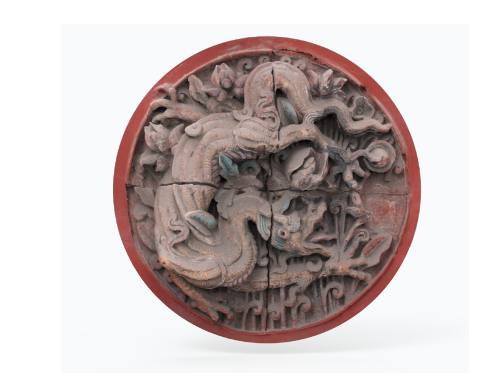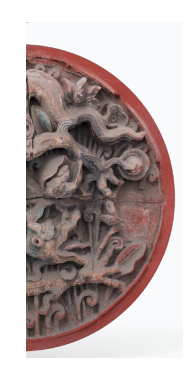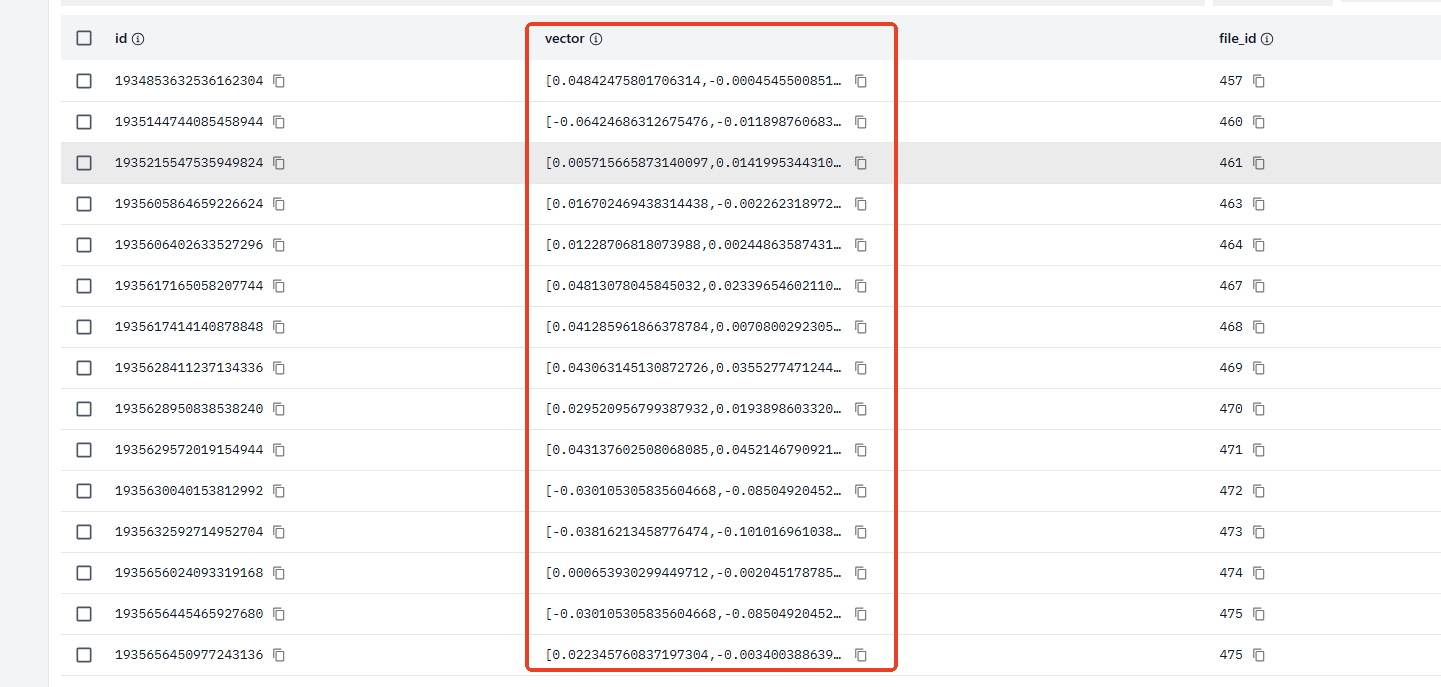背景
最近再做项目的时候,里面有个AI检索的功能,其中一个点就是要实现以图搜图,也就是用户上传一张图,要找出相似度比较高的图,比如下面这样,第一张是原图,第二张是图中的一部分,用户上传第二张图,要能检索到第一张完整的图


实现思路
整个实现的核心就是用向量检索,也就是在运营端上传第一张图片的时候,先把整个图片转换为向量,存储到向量数据库中,然后用户在检索的时候,把第二张图再转换为向量,与第一张图的向量进行对比,比如余弦相似度,当然,这里不用我们自己去实现,向量数据库已经实现了,我们只需要像查询普通的关系型数据库一样查询就行,整个连路途如下:


项目的后台web采用的是springboot实现,将图片转换为向量时会涉及到与python程序的交互,此处是用python的flask暴露一http接口供java调用
其中模型转换是用的BGE-VL这个模型,通过它把图片转换为向量,然后进行入库或者检索,关于该模型的详细信息,可以参考github链接:https://github.com/VectorSpaceLab/MegaPairs
向量数据库使用的是Milvus,这个数据库官方说是单机节点即可支撑10亿级别的向量数据检索,并且安装也很方便:Run Milvus in Docker (Linux) | Milvus Documentation,如果不想安装的话,有相应的python版本的数据库,也就是通过pip命令安装好milvus的依赖之后,就自带了的milvus数据库,如果是自己安装的话,官方提供了可视化的客户端工具Attu
代码实现
将图片转换为向量的核心代码用python实现如下:
import torch
from transformers import AutoModel
import os
# 使用本地模型路径
MODEL_PATH = "../bgevl" # 指向本地模型文件夹
# 获取绝对路径以确保路径正确
current_dir = os.path.dirname(os.path.abspath(__file__))
model_path = os.path.join(os.path.dirname(current_dir), "bgevl")
print(f"正在加载本地BGE-VL模型: {model_path}")
try:
# 从本地路径加载模型,添加local_files_only=True确保只使用本地文件
model = AutoModel.from_pretrained(
model_path,
trust_remote_code=True,
local_files_only=True # 强制使用本地文件
)
# 设置处理器也使用本地路径
model.set_processor(model_path)
model.eval()
print("✅ 本地BGE-VL模型加载成功!")
except Exception as e:
print(f"❌ 本地模型加载失败: {e}")
print("尝试使用相对路径...")
# 如果绝对路径失败,尝试相对路径
model = AutoModel.from_pretrained(
"../bgevl",
trust_remote_code=True,
local_files_only=True
)
model.set_processor("../bgevl")
model.eval()
print("✅ 模型加载成功!")
# 使用模型进行推理
with torch.no_grad():
print("正在处理查询图片和文本...")
query = model.encode(
images="../images/sample2.png",
)
print("正在处理候选图片...")
candidates = model.encode(
images=["../images/sample.png", "../images/ceshi2.png"]
)
# 计算相似度分数
scores = query @ candidates.T
print(f"相似度分数: {scores}")
print(f"查询向量维度: {query.shape}")
print(f"候选向量维度: {candidates.shape}")完整版暴露http接口实现如下,其中既可以传递文件流的方式,也可以传递文件的url(因为有些图片是上传到oss的)
from flask import Flask, request, jsonify
from flask_cors import CORS
import os
import sys
import traceback
import numpy as np
from werkzeug.utils import secure_filename
import tempfile
import base64
from io import BytesIO
from PIL import Image
# 添加vector模块到路径
sys.path.append(os.path.join(os.path.dirname(__file__), 'vector'))
# 导入向量化器
from vector.TransformerImgToVector import ImageVectorizerAlternative
app = Flask(__name__)
CORS(app) # 允许跨域请求
# 配置
app.config['MAX_CONTENT_LENGTH'] = 16 * 1024 * 1024 # 16MB max file size
UPLOAD_FOLDER = 'temp_uploads'
ALLOWED_EXTENSIONS = {'png', 'jpg', 'jpeg', 'gif', 'bmp', 'webp'}
# 确保上传文件夹存在
os.makedirs(UPLOAD_FOLDER, exist_ok=True)
# 全局变量存储模型实例
bge_model = None
def allowed_file(filename):
"""
检查文件扩展名是否允许
Args:
filename (str): 文件名
Returns:
bool: 是否允许的文件类型
"""
return '.' in filename and filename.rsplit('.', 1)[1].lower() in ALLOWED_EXTENSIONS
def init_models():
"""
初始化所有模型
"""
global bge_model
try:
print("正在初始化BGE-VL模型...")
# 这里需要根据你的BGE-VL模型加载逻辑进行调整
current_dir = os.path.dirname(os.path.abspath(__file__))
model_path = os.path.join(current_dir, "bgevl")
from transformers import AutoModel
bge_model = AutoModel.from_pretrained(
model_path,
trust_remote_code=True,
local_files_only=True
)
bge_model.set_processor(model_path)
bge_model.eval()
print("✅ BGE-VL模型初始化成功")
except Exception as e:
print(f"❌ BGE-VL模型初始化失败: {e}")
bge_model = None
def save_base64_image(base64_string):
"""
保存base64编码的图片到临时文件
Args:
base64_string (str): base64编码的图片数据
Returns:
str: 临时文件路径
"""
try:
# 解码base64
image_data = base64.b64decode(base64_string)
image = Image.open(BytesIO(image_data))
# 创建临时文件
temp_file = tempfile.NamedTemporaryFile(delete=False, suffix='.png', dir=UPLOAD_FOLDER)
image.save(temp_file.name, 'PNG')
temp_file.close()
return temp_file.name
except Exception as e:
raise ValueError(f"无效的base64图片数据: {e}")
@app.route('/', methods=['GET'])
def health_check():
"""
健康检查接口
"""
return jsonify({
'status': 'success',
'message': '图像向量化API服务正常运行',
'models': {
'bge_vl': bge_model is not None
}
})
@app.route('/api/bge/encode', methods=['POST', 'GET'])
def bge_encode():
"""
BGE-VL模型编码接口
支持图像和文本的联合编码
GET请求参数:
- url: 远程图片URL
- path: 本地图片路径
- text: 文本内容(可选)
POST请求:保持原有JSON格式
"""
if bge_model is None:
return jsonify({
'status': 'error',
'message': 'BGE-VL模型未初始化'
}), 500
try:
images = []
text = ''
temp_files = []
# 处理GET请求
if request.method == 'GET':
# 从URL参数获取图片和文本
image_url = request.args.get('url')
local_path = request.args.get('path')
text = request.args.get('text', '')
if image_url:
images = [image_url]
elif local_path:
images = [local_path]
elif not text:
return jsonify({
'status': 'error',
'message': '请提供url、path或text参数'
}), 400
# 处理POST请求(保持原有逻辑)
elif request.method == 'POST':
data = request.get_json()
if not data:
return jsonify({'status': 'error', 'message': '无效的JSON数据'}), 400
images = data.get('images', [])
text = data.get('text', '')
if not images and not text:
return jsonify({'status': 'error', 'message': '请提供图像或文本数据'}), 400
# 处理图像路径 - 添加强化的远程URL下载逻辑
processed_images = []
for img in images:
if isinstance(img, str):
if img.startswith('data:image'):
# Base64图像
base64_data = img.split(',')[1]
temp_file = save_base64_image(base64_data)
processed_images.append(temp_file)
temp_files.append(temp_file)
elif img.startswith('http://') or img.startswith('https://'):
# 远程URL - 使用多种方法绕过代理问题
import tempfile
from urllib.parse import urlparse
try:
# 方法1: 使用requests禁用代理
import requests
import os
# 临时清除代理环境变量
original_proxies = {}
proxy_vars = ['HTTP_PROXY', 'HTTPS_PROXY', 'http_proxy', 'https_proxy']
for var in proxy_vars:
if var in os.environ:
original_proxies[var] = os.environ[var]
del os.environ[var]
try:
# 创建session并禁用代理
session = requests.Session()
session.trust_env = False
session.proxies = {}
# 设置请求头
headers = {
'User-Agent': 'Mozilla/5.0 (Windows NT 10.0; Win64; x64) AppleWebKit/537.36 (KHTML, like Gecko) Chrome/91.0.4472.124 Safari/537.36'
}
response = session.get(img, headers=headers, timeout=30, verify=False)
response.raise_for_status()
finally:
# 恢复原始代理设置
for var, value in original_proxies.items():
os.environ[var] = value
except Exception as e1:
print(f"方法1失败: {e1}")
try:
# 方法2: 使用urllib绕过代理
import urllib.request
import urllib.error
# 创建不使用代理的opener
proxy_handler = urllib.request.ProxyHandler({})
opener = urllib.request.build_opener(proxy_handler)
# 设置请求头
req = urllib.request.Request(
img,
headers={
'User-Agent': 'Mozilla/5.0 (Windows NT 10.0; Win64; x64) AppleWebKit/537.36'
}
)
with opener.open(req, timeout=30) as response:
image_data = response.read()
# 模拟response对象
class MockResponse:
def __init__(self, content):
self.content = content
response = MockResponse(image_data)
except Exception as e2:
print(f"方法2失败: {e2}")
try:
# 方法3: 使用httpx库(如果可用)
import httpx
with httpx.Client(proxies={}, verify=False) as client:
response = client.get(img, timeout=30)
response.raise_for_status()
# 模拟response对象
class MockResponse:
def __init__(self, content):
self.content = content
response = MockResponse(response.content)
except Exception as e3:
return jsonify({
'status': 'error',
'message': f'所有下载方法都失败了。方法1: {str(e1)}, 方法2: {str(e2)}, 方法3: {str(e3)}'
}), 400
# 获取文件扩展名
parsed_url = urlparse(img)
file_ext = os.path.splitext(parsed_url.path)[1] or '.jpg'
# 创建临时文件
temp_file = tempfile.NamedTemporaryFile(delete=False, suffix=file_ext, dir=UPLOAD_FOLDER)
temp_file.write(response.content)
temp_file.close()
processed_images.append(temp_file.name)
temp_files.append(temp_file.name)
else:
# 本地路径
processed_images.append(img)
# 在BGE编码部分(大约第395-410行),修改编码逻辑
# 编码
import torch
with torch.no_grad():
if text and processed_images:
# 图像+文本编码 - 确保类型一致
if len(processed_images) == 1 and isinstance(text, str):
# 单个图像和单个文本:都转换为字符串
encoded = bge_model.encode(images=processed_images[0], text=text)
else:
# 多个图像或文本:都转换为列表
if isinstance(text, str):
text_list = [text] * len(processed_images) # 为每个图像复制文本
else:
text_list = text
encoded = bge_model.encode(images=processed_images, text=text_list)
elif processed_images:
# 仅图像编码
if len(processed_images) == 1:
encoded = bge_model.encode(images=processed_images[0])
else:
encoded = bge_model.encode(images=processed_images)
else:
# 仅文本编码
encoded = bge_model.encode(text=text)
# 清理临时文件
for temp_file in temp_files:
if os.path.exists(temp_file):
os.remove(temp_file)
return jsonify({
'status': 'success',
'vector': encoded.tolist() if hasattr(encoded, 'tolist') else encoded,
'dimension': encoded.shape if hasattr(encoded, 'shape') else len(encoded),
'model': 'BGE-VL'
})
except Exception as e:
# 清理临时文件
for temp_file in temp_files:
if os.path.exists(temp_file):
os.remove(temp_file)
return jsonify({
'status': 'error',
'message': f'编码失败: {str(e)}',
'traceback': traceback.format_exc()
}), 500
@app.route('/api/bge/encode-stream', methods=['POST'])
def bge_encode_stream():
"""
BGE-VL模型统一编码接口
支持三种向量化模式:
1. 仅文字向量化:只传text参数
2. 仅图片向量化:只传file参数
3. 文字+图片联合向量化:同时传text和file参数
请求方式:
- POST multipart/form-data
- 参数:
- file: 图片文件流(可选)
- text: 文本内容(可选)
- 注意:file和text至少提供一个
返回:
- 成功:返回向量数据和维度信息
- 失败:返回错误信息
"""
if bge_model is None:
return jsonify({
'status': 'error',
'message': 'BGE-VL模型未初始化'
}), 500
try:
# 获取文本参数
text = request.form.get('text', '').strip()
# 检查文件上传
has_file = 'file' in request.files and request.files['file'].filename != ''
has_text = bool(text)
# 验证至少有一个输入
if not has_file and not has_text:
return jsonify({
'status': 'error',
'message': '请至少提供文件或文本内容中的一个'
}), 400
temp_files = []
processed_images = []
filename = None
input_type = None
# 处理文件(如果有)
if has_file:
file = request.files['file']
# 检查文件类型
if not allowed_file(file.filename):
return jsonify({
'status': 'error',
'message': f'不支持的文件类型,支持的格式:{", ".join(ALLOWED_EXTENSIONS)}'
}), 400
# 保存上传的文件到临时目录
filename = secure_filename(file.filename)
temp_file_path = os.path.join(UPLOAD_FOLDER, filename)
file.save(temp_file_path)
temp_files.append(temp_file_path)
processed_images.append(temp_file_path)
# 确定输入类型
if has_file and has_text:
input_type = 'image+text'
elif has_file:
input_type = 'image_only'
else:
input_type = 'text_only'
try:
# 使用BGE-VL模型进行编码
import torch
with torch.no_grad():
if input_type == 'image+text':
# 图像+文本联合编码
encoded = bge_model.encode(images=processed_images[0], text=text)
elif input_type == 'image_only':
# 仅图像编码
encoded = bge_model.encode(images=processed_images[0])
elif input_type == 'text_only':
# 仅文本编码
encoded = bge_model.encode(text=text)
else:
return jsonify({
'status': 'error',
'message': '未知的输入类型'
}), 400
# 清理临时文件
for temp_file in temp_files:
if os.path.exists(temp_file):
os.remove(temp_file)
# 构建响应
response_data = {
'status': 'success',
'vector': encoded.tolist() if hasattr(encoded, 'tolist') else encoded,
'dimension': encoded.shape if hasattr(encoded, 'shape') else len(encoded),
'model': 'BGE-VL',
'input_type': input_type
}
# 添加文件名(如果有)
if filename:
response_data['filename'] = filename
# 添加文本内容(如果有且不太长)
if has_text and len(text) <= 100:
response_data['text_preview'] = text
elif has_text:
response_data['text_preview'] = text[:100] + '...'
return jsonify(response_data)
except Exception as e:
# 清理临时文件
for temp_file in temp_files:
if os.path.exists(temp_file):
os.remove(temp_file)
return jsonify({
'status': 'error',
'message': f'BGE-VL编码失败: {str(e)}',
'traceback': traceback.format_exc()
}), 500
except Exception as e:
return jsonify({
'status': 'error',
'message': f'请求处理失败: {str(e)}',
'traceback': traceback.format_exc()
}), 500
@app.route('/api/bge/encode-multi-stream', methods=['POST'])
def bge_encode_multi_stream():
"""
BGE-VL模型多文件流编码接口
支持同时上传多个文件流进行批量向量化处理
请求方式:
- POST multipart/form-data
- 参数:
- files: 多个图片文件流(必需)
- text: 文本内容(可选)
返回:
- 成功:返回向量数据和维度信息
- 失败:返回错误信息
"""
if bge_model is None:
return jsonify({
'status': 'error',
'message': 'BGE-VL模型未初始化'
}), 500
try:
# 检查是否有文件上传
if 'files' not in request.files:
return jsonify({
'status': 'error',
'message': '没有上传文件流'
}), 400
files = request.files.getlist('files')
if not files or all(f.filename == '' for f in files):
return jsonify({
'status': 'error',
'message': '没有选择有效文件'
}), 400
# 获取可选的文本参数
text = request.form.get('text', '')
# 处理多个文件
temp_files = []
processed_images = []
filenames = []
for file in files:
if file.filename != '' and allowed_file(file.filename):
# 保存文件到临时目录
filename = secure_filename(file.filename)
temp_file_path = os.path.join(UPLOAD_FOLDER, filename)
file.save(temp_file_path)
temp_files.append(temp_file_path)
processed_images.append(temp_file_path)
filenames.append(filename)
if not processed_images:
return jsonify({
'status': 'error',
'message': f'没有有效的图片文件,支持的格式:{", ".join(ALLOWED_EXTENSIONS)}'
}), 400
try:
# 使用BGE-VL模型进行批量编码
import torch
with torch.no_grad():
if text and processed_images:
# 图像+文本联合编码
encoded = bge_model.encode(images=processed_images, text=text)
elif processed_images:
# 仅图像编码
encoded = bge_model.encode(images=processed_images)
else:
return jsonify({
'status': 'error',
'message': '没有提供有效的图像或文本数据'
}), 400
# 清理临时文件
for temp_file in temp_files:
if os.path.exists(temp_file):
os.remove(temp_file)
return jsonify({
'status': 'success',
'vector': encoded.tolist() if hasattr(encoded, 'tolist') else encoded,
'dimension': encoded.shape if hasattr(encoded, 'shape') else len(encoded),
'model': 'BGE-VL',
'input_type': 'images+text' if text else 'images_only',
'file_count': len(filenames),
'filenames': filenames
})
except Exception as e:
# 清理临时文件
for temp_file in temp_files:
if os.path.exists(temp_file):
os.remove(temp_file)
return jsonify({
'status': 'error',
'message': f'BGE-VL批量编码失败: {str(e)}',
'traceback': traceback.format_exc()
}), 500
except Exception as e:
return jsonify({
'status': 'error',
'message': f'多文件流处理失败: {str(e)}',
'traceback': traceback.format_exc()
}), 500
@app.route('/api/similarity', methods=['POST'])
def calculate_similarity():
"""
计算向量相似度接口
"""
try:
data = request.get_json()
if not data:
return jsonify({'status': 'error', 'message': '无效的JSON数据'}), 400
vector1 = np.array(data.get('vector1', []))
vector2 = np.array(data.get('vector2', []))
if len(vector1) == 0 or len(vector2) == 0:
return jsonify({'status': 'error', 'message': '请提供两个向量'}), 400
if len(vector1) != len(vector2):
return jsonify({'status': 'error', 'message': '向量维度不匹配'}), 400
# 计算余弦相似度
similarity = np.dot(vector1, vector2) / (np.linalg.norm(vector1) * np.linalg.norm(vector2))
return jsonify({
'status': 'success',
'similarity': float(similarity),
'vector1_dim': len(vector1),
'vector2_dim': len(vector2)
})
except Exception as e:
return jsonify({
'status': 'error',
'message': f'相似度计算失败: {str(e)}'
}), 500
if __name__ == '__main__':
print("正在启动图像向量化API服务...")
init_models()
print("\n🚀 服务启动成功!")
print("API文档:")
print(" - GET / : 健康检查")
print(" - POST /api/clip/vectorize : CLIP图像向量化")
print(" - POST /api/bge/encode : BGE-VL编码")
print(" - POST /api/similarity : 向量相似度计算")
print("\n访问地址: http://localhost:5000")
app.run(host='0.0.0.0', port=5000, debug=True)java操作milvus数据库核心代码:
import cn.hutool.core.collection.CollectionUtil;
import cn.hutool.core.util.IdUtil;
import io.milvus.client.MilvusServiceClient;
import io.milvus.common.clientenum.ConsistencyLevelEnum;
import io.milvus.grpc.DataType;
import io.milvus.grpc.DescribeCollectionResponse;
import io.milvus.grpc.MutationResult;
import io.milvus.grpc.SearchResults;
import io.milvus.param.IndexType;
import io.milvus.param.MetricType;
import io.milvus.param.R;
import io.milvus.param.RpcStatus;
import io.milvus.param.collection.*;
import io.milvus.param.dml.InsertParam;
import io.milvus.param.dml.SearchParam;
import io.milvus.param.index.CreateIndexParam;
import org.springframework.beans.factory.annotation.Autowired;
import org.springframework.stereotype.Service;
import java.util.ArrayList;
import java.util.Arrays;
import java.util.List;
import java.util.Map;
/**
* Milvus 操作服务类
*/
@Service
public class MilvusService {
@Autowired
private MilvusServiceClient milvusClient;
/**
* 创建集合(Collection)
* @param collectionName 集合名称
* @param dimension 向量维度
* @return 是否创建成功
*/
public boolean createCollection(String collectionName, int dimension) {
try {
// 定义字段
FieldType idField = FieldType.newBuilder()
.withName("id")
.withDataType(DataType.Int64)
.withPrimaryKey(true)
.withAutoID(true)
.build();
FieldType vectorField = FieldType.newBuilder()
.withName("vector")
.withDataType(DataType.FloatVector)
.withDimension(dimension)
.build();
// 创建集合模式
CreateCollectionParam createCollectionParam = CreateCollectionParam.newBuilder()
.withCollectionName(collectionName)
.withDescription("图像向量集合")
.addFieldType(idField)
.addFieldType(vectorField)
.build();
R<RpcStatus> response = milvusClient.createCollection(createCollectionParam);
return response.getStatus() == R.Status.Success.getCode();
} catch (Exception e) {
e.printStackTrace();
return false;
}
}
/**
* 创建索引
* @param collectionName 集合名称
* @return 是否创建成功
*/
public boolean createIndex(String collectionName) {
try {
CreateIndexParam createIndexParam = CreateIndexParam.newBuilder()
.withCollectionName(collectionName)
.withFieldName("vector")
.withIndexType(IndexType.IVF_FLAT)
.withMetricType(MetricType.L2)
.withExtraParam("{\"nlist\":1024}")
.build();
R<RpcStatus> response = milvusClient.createIndex(createIndexParam);
return response.getStatus() == R.Status.Success.getCode();
} catch (Exception e) {
e.printStackTrace();
return false;
}
}
/**
* 加载集合到内存
* @param collectionName 集合名称
* @return 是否加载成功
*/
public boolean loadCollection(String collectionName) {
try {
LoadCollectionParam loadCollectionParam = LoadCollectionParam.newBuilder()
.withCollectionName(collectionName)
.build();
R<RpcStatus> response = milvusClient.loadCollection(loadCollectionParam);
return response.getStatus() == R.Status.Success.getCode();
} catch (Exception e) {
e.printStackTrace();
return false;
}
}
/**
* 插入向量数据
* @param collectionName 集合名称
* @param vectors 向量列表
* otherFields 其他字段
* @return 插入的ID列表
*/
public List<Long> insertVectors(String collectionName, List<List<Float>> vectors, Map<String,Object> otherFields) {
try {
List<InsertParam.Field> fields = new ArrayList<>();
// 添加向量字段
fields.add(new InsertParam.Field("vector", vectors));
fields.add(new InsertParam.Field("id", List.of(IdUtil.getSnowflakeNextId())));
if (!CollectionUtil.isEmpty(otherFields)) {
otherFields.forEach((k, v) -> {
fields.add(new InsertParam.Field(k, List.of(v)));
});
}
InsertParam insertParam = InsertParam.newBuilder()
.withCollectionName(collectionName)
.withFields(fields)
.build();
R<MutationResult> response = milvusClient.insert(insertParam);
if (response.getStatus() == R.Status.Success.getCode()) {
return response.getData().getIDs().getIntId().getDataList();
}
} catch (Exception e) {
e.printStackTrace();
}
return new ArrayList<>();
}
/**
* 向量相似性搜索
* @param collectionName 集合名称
* @param queryVectors 查询向量
* @param topK 返回最相似的K个结果
* @return 搜索结果
*/
public List<SearchResult> searchVectors(String collectionName, List<List<Float>> queryVectors, int topK) {
try {
R<Boolean> hasCollection = milvusClient.hasCollection(
HasCollectionParam.newBuilder()
.withCollectionName("file_collection")
.build()
);
System.out.println("Has collection: " + hasCollection.getData());
SearchParam searchParam = SearchParam.newBuilder()
.withCollectionName(collectionName)
.withConsistencyLevel(ConsistencyLevelEnum.STRONG)
.withMetricType(MetricType.IP)
.withOutFields(Arrays.asList("id", "file_id")) // 添加 file_id 字段到输出
.withTopK(topK)
.withVectors(queryVectors)
.withVectorFieldName("vector")
.withParams("{\"nprobe\":10}")
.build();
R<SearchResults> response = milvusClient.search(searchParam);
if (response.getStatus() == R.Status.Success.getCode()) {
return parseSearchResults(response.getData());
}
} catch (Exception e) {
e.printStackTrace();
}
return new ArrayList<>();
}
/**
* 解析搜索结果
* @param searchResults 原始搜索结果
* @return 格式化的搜索结果
*/
private List<SearchResult> parseSearchResults(SearchResults searchResults) {
List<SearchResult> results = new ArrayList<>();
for (int i = 0; i < searchResults.getResults().getNumQueries(); i++) {
for (int j = 0; j < searchResults.getResults().getTopK(); j++) {
int index = (int) (i * searchResults.getResults().getTopK() + j);
long id = searchResults.getResults().getIds().getIntId().getData(index);
float score = searchResults.getResults().getScores(index);
// 获取 file_id 字段值
String fileId = null;
try {
// 检查是否有字段数据
if (searchResults.getResults().getFieldsDataList() != null &&
!searchResults.getResults().getFieldsDataList().isEmpty()) {
// 遍历字段数据找到 file_id
for (var fieldData : searchResults.getResults().getFieldsDataList()) {
if ("file_id".equals(fieldData.getFieldName())) {
// 根据字段类型获取值
if (fieldData.getScalars().hasStringData()) {
var stringDataList = fieldData.getScalars().getStringData().getDataList();
if (index < stringDataList.size()) {
fileId = stringDataList.get(index);
}
} else if (fieldData.getScalars().hasLongData()) {
var longDataList = fieldData.getScalars().getLongData().getDataList();
if (index < longDataList.size()) {
fileId = String.valueOf(longDataList.get(index));
}
}
break;
}
}
}
} catch (Exception e) {
// 如果获取 file_id 失败,记录日志但不影响主要结果
System.err.println("获取 file_id 失败: " + e.getMessage());
}
results.add(new SearchResult(id, score, fileId));
}
}
return results;
}
/**
* 删除集合
* @param collectionName 集合名称
* @return 是否删除成功
*/
public boolean dropCollection(String collectionName) {
try {
DropCollectionParam dropCollectionParam = DropCollectionParam.newBuilder()
.withCollectionName(collectionName)
.build();
R<RpcStatus> response = milvusClient.dropCollection(dropCollectionParam);
return response.getStatus() == R.Status.Success.getCode();
} catch (Exception e) {
e.printStackTrace();
return false;
}
}
/**
* 搜索结果内部类
*/
public static class SearchResult {
private long id;
private float score;
private String fileId; // 新增 fileId 字段
public SearchResult(long id, float score) {
this.id = id;
this.score = score;
}
public SearchResult(long id, float score, String fileId) {
this.id = id;
this.score = score;
this.fileId = fileId;
}
// Getters and Setters
public long getId() { return id; }
public void setId(long id) { this.id = id; }
public float getScore() { return score; }
public void setScore(float score) { this.score = score; }
public String getFileId() { return fileId; }
public void setFileId(String fileId) { this.fileId = fileId; }
}
}其中的SearchResult需要自行根据项目的数据来定,重点是insertVectors写入数据和searchVectors查询数据这两个方法的实现
,milvus在定义数据索引(类似于关系型数据库的表)的时候必须包含一个主键id和vevtor字段,vector就是存储的图片的向量,file_id是自定义的字段,根据业务需求来定即可,我这里的file_id是图片文件对应的mysql数据表里面的主键id